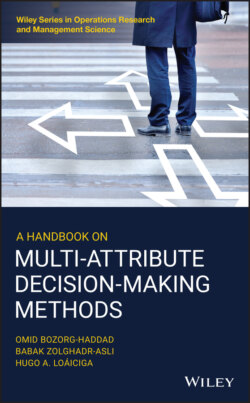Читать книгу A Handbook on Multi-Attribute Decision-Making Methods - Omid Bozorg-Haddad - Страница 15
1.3 Brief Chronicle of MADM Methods
ОглавлениеThe historical origins of MADM can be traced back to series of correspondence letter between Nicolas Bernoulli (1687–1759) and Pierre Rémond de Montmort (1678–1719), while discussing a mathematical brain teaser, known as the St. Petersburg paradox (Tzeng and Huang 2011). In brief, the St. Petersburg paradox can be portrayed as follows (Bernstein 1996):
“This is a game of chance for a single player who tosses a fair coin at each stage of the game. The player keeps tossing the coin until it turns tails. If the first flip is tails the player wins $2; if the first tails is on the second flip the player wins $4; if the first tails is on the third flip the player wins $8, etc. Concretely if first tails is on the nth flip the player wins $2n.” The question here is: how much would a prospective gambler be willing to pay to play this game?
To grasp the magnitude of the described conundrum, consider for a moment, the answer of classical mathematics to the described question. The expected value of the prize resulting from playing this game is (Bernoulli 1738):
(1.1)
in which EV = the expected value turns out to be infinity. Accordingly, a player would be willing to pay any price to participate in the described game. However, this result defies human behavior since no one would be willing to pay a limitless amount of cash to engage in this game (Rieger and Wang 2006). The answer to the St. Petersburg paradox, which revolutionized the way in which decision‐making problems were analyzed, did not surface itself until Daniel Bernoulli (1700–1782) published his influential research on utility theory in 1738. The concrete discussions describing the solution of the St. Petersburg paradox in detail are skipped here; yet, it is noteworthy that the remarkable solution that enabled Daniel Bernoulli to solve the aforementioned paradox relied on the fact that humans make decisions based not on the expected value, but rather, on the utility value. Specifically, assume that a prospective player has a wealth of w dollars, that the charge for entering the game equals c dollars, and that the player’s utility function is U(w) = ln(w). It can be shown that under these circumstances, the expected incremental (or marginal) utility of playing this game [EΔ(U)] is finite:
(1.2)
Therefore, a prospective player whose wealth equals US$106 should be willing to pay up to US$20.88 to play the game; or US$10.95 if the wealth is US$103, and so on and so forth, because the amounts the player would be willing to pay maximize his expected incremental utility. The implication of the utility value is that humans choose the alternative with the highest expected utility value when confronting the MADM problems. A chronologic overview of the most fundamental and influential MADM methods, which would be discussed within this book, is presented in Table 1.2.
Table 1.2 A chronologic overview of the most influential MADM methods.
| MADM Methods | Utility function | Bernoulli (1738) |
| Weighted sum method (WSM) | Churchman and Ackoff (1954) | |
| ELECTERE I | Benayoun et al. (1966) | |
| ELECTERE II | Roy and Bertier (1971) | |
| Analytic hierarchy process (AHP) | Saaty (1977) | |
| ELECTERE III | Roy (1978) | |
| TOPSIS | Hwang and Yoon (1981) | |
| ELECTERE IV | Roy and Hugonnard (1982) | |
| PROMETHEE I | Brans (1982) | |
| PROMETHEE II | Vincke and Brans (1985) | |
| PROMETHEE III | Brans et al. (1986) | |
| PROMETHEE IV | Mladineo et al. (1987) | |
| Grey relational analysis | Deng (1989) | |
| Analytic network process (ANP) | Saaty (1996) | |
| VIKOR | Opricovic (1998) | |
| Superiority and inferiority ranking (SIR) | Xu (2001) | |
| PAPRIKA | Hansen and Ombler (2008) | |
| Best‐worst method (BWM) | Rezaei et al. (2015) | |
| Weighting Methods | Entropy method | Shannon (1948) |
| Delphi method | Dalkey and Helmer (1963) | |
| Eigenvector method | Saaty (1977) | |
| Weighted least square method | Chu et al. (1979) | |
| Multiple objective programming model | Choo and Wedley (1985) | |
| Principal element analysis | Fan (1996) | |
| Modified Delphi method | Custer et al. (1999) |
